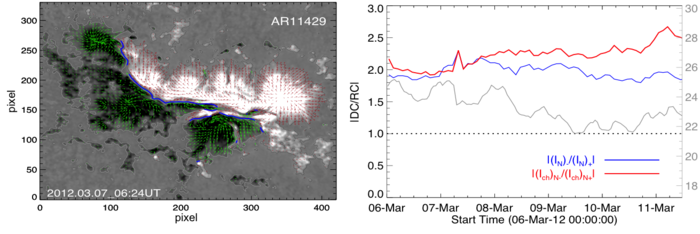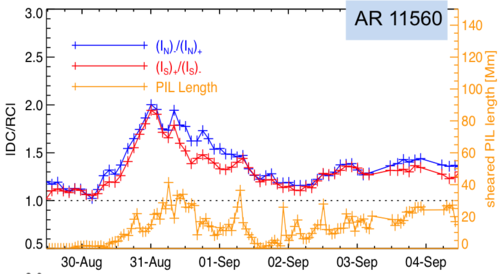Relation of Non-neutralized electric currents and the activity in active regions
From RHESSI Wiki
| Nugget | |
|---|---|
| Number: | 386 |
| 1st Author: | P. VEMAREDDY |
| 2nd Author: | |
| Published: | 24 August 2020 |
| Next Nugget: | TBD |
| Previous Nugget: | White-light emission and photospheric magnetic field changes in flares |
| List all | |
Contents |
Introduction
Transient eruptive events (flares, CMEs, jets etc.) derive their energy from electrical currents that pass through the solar atmosphere. There are evidential reports that the strong electrical currents involved in major flares are embedded within magnetic flux that has emerged from the convection zone through the photosphere into the corona. We identify these currents via the twisting of the field, or by other means such as Faraday's Law as applied to the Zeeman effect observed in the solar photosphere.
According to Parker (Ref. [1]), the net electric current at any cross-section of a magnetic flux tube embedded in relatively field-free plasma must result in a zero value, which turns out not to be the case observationally (Ref. [2]). A study of two active regions (Ref. [3]) appears to have resolved the debate. Intense polarity inversion lines (PILs) amid the compact polarities of these active regions contribute significantly to non-neutralized coronal currents. This also suggests that the length of strong magnetically sheared PIL (SPIL) may be proportional to the observed net current. In this context, a very early study in 2001 (Ref. [4]) was the basis for this well-proven relation of strong SPIL being an indicator for the occurrence of eruptions with its length a measure of the net vertical current.
Analysis
From the net vertical current distribution computed from vector field measurements in the photosphere, jz ~ (∇ x B)z, we deduce the net current by summing over the pixels of a particular polarity. In each polarity, the absolute ratio (|DC/RC|) of dominant and non-dominant net current is evaluated with the flux evolution in the active region. A ratio of unity indicates neutralized currents in that polarity. Higher than unity indicates non-neutralized net current and is a special case of non-potentiality. The breakdown of net current neutralization (NCN) implies a form of Lorentz force development leading to stability loss and CME eruption, according to flux-rope models of eruptions.
Figure 1: Degree of net electric current neutralization in AR 11429. Left panel: A sample vector magnetogram is with traced SPILs (the blue curves). Transverse field vectors are shown with the red (green) arrows in north (south) polarity regions. Axis units are in 0.5 arcsec pixels. The right panel shows the evolution of |DC/RC| in the north polarity. The right panel shows the evolution of |DC/RC| in the north (Bz > 0 polarity. Net magnetic flux (in units of 1021 Maxwell) is plotted in grey with y-axis scale on right. The horizontal dotted line marks current neutralization level of unity. Note that |DC/RC| for Jzch (volume currents) is dominant than for Jz indicating the additional contribution of Jzch in the NCN. In an emerging active region, the non-neutrality of the coronal currents appears to build up from the onset of flux emergence, followed by a relaxation to neutrality during the separation of the two polarities. As a result, those emerging ARs are source regions of CMEs occurring at the time of a higher level of non-neutrality. ARs in the post-phase of their emergence can be CME-productive provided they have interacting bipolar regions with converging and shearing motions. In these cases, the net current evolves with higher level (>1.3) of non-neutrality. The NCN in the AR 11429 is plotted in Figure 1. The net current evolution in flaring and quiet ARs is different. The |DC/RC| in these cases varies near unity indicating neutralized currents in the magnetic polarities (Ref. [3]). These observations demonstrate that CME eruptions can be due to non-neutralized currents in the ARs (Ref. [5]).
From the decomposition of the electric current into shear and chiral components, in all the AR cases, we found that the |DC/RC| is more for Jzch than for Jz. It implies that the current due to field strength gradients the Jzsh have opposite sign distribution dominantly (60-65 percent) to that of field direction Jzch. Apart from its role in current neutralization, Ish can be the origin of shear-generating Lorentz force, which further connected to non-neutralized currents and the solar activity in the ARs (Ref. [1]).
Owing to the fact that non-neutralized currents arise in the vicinity of SPILs, the total length of SPIL segments follows the degree of NCN with a strong correlation in AR 11560 as shown in Figure 2. From this study, we notice that the SPIL is continuous in CME-producing ARs in contrast to multiple small segments in flaring ARs that makes a clear difference in the magnetic shear distribution in the AR scale in which we refer as "global shear" in the former cases and "local shear" in the later cases.
Figure 2: Relationship between SPIL length and |DC/RC| in ARs 11560. Total length of all SPIL segments is plotted with time with y-axis scale on right-hand side. Note that SPIL length correlates well (CC = 0.69) with the non-neutralization.
Conclusion
We have studied net current neutralization (NCN) in solar active regions. Our study of (Ref. [2]) suggests that dividing line between CMEs and flares with the difference being in the global or more local nature of the magnetic shear in the region.
References
[1] "Inferring Mean Electric Currents in Unresolved Fibril Magnetic Fields"
[4] "A prospective method for predicting coronal mass ejections from vector magnetograms"
[5] "Electric-current Neutralization, Magnetic Shear, and Eruptive Activity in Solar Active Regions"
| RHESSI Nugget Date | 24 August 2020 + |
| RHESSI Nugget First Author | P. VEMAREDDY + |
| RHESSI Nugget Index | 386 + |

